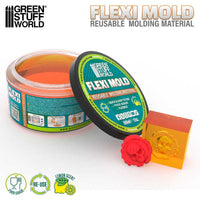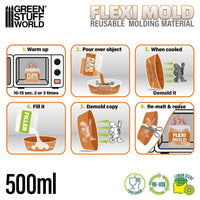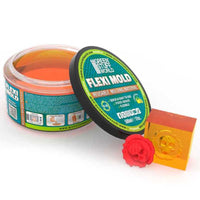Green Stuff World Flexi Mold – Reusable Molding Material 500ml
🔄 Flexi Mold by Green Stuff World
Reusable Mold Making Material That Pays for Itself
Why Artists Choose Flexi Mold
Traditional silicone molds cost £15-40 and you can use them once. Flexi Mold costs less upfront and you can melt it down and remake it over 35 times (100+ with proper care). That's like getting 35 molds for the price of one. Plus, it's actually biodegradable, so you're not adding more plastic waste to your studio.
⚡ What You Get
Microwave for 2-3 minutes, pour over your master, wait 2 hours. No mixing, no measuring, no mess.
Reproduces textures, panel lines, and surface details that other materials miss. Perfect for miniatures and jewelry.
Mold didn't work? Just reheat it and try again. No wasted material, no second purchase needed.
Biodegradable formula without petroleum ingredients. When you're done (after 100+ uses), it breaks down naturally.
Make molds for chocolate, candy, ice cubes, soap, bath bombs—anything that touches skin or food.
Soft enough to demold easily, tough enough to handle repeated casting without tearing.
📊 Technical Details
| Property | Specification |
|---|---|
| Setting Time | ~2 hours at room temperature | 30-45 minutes in fridge |
| Reuse Cycles | 35+ guaranteed | 100+ with proper storage |
| Heating Method | Microwave (recommended) or hot water bath |
| Working Temperature | Liquid at 65-75°C | Sets at room temperature |
| Compatible Materials | Epoxy resin, UV resin, plaster, wax, soap, chocolate, concrete, polymer clay |
| Material Composition | Biodegradable thermoplastic | Petroleum-free | Food contact safe |
| Release Agent | Not required for most materials | Optional for complex shapes |
| Detail Reproduction | High fidelity | Captures 0.1mm features |
🛠️ How to Use Flexi Mold
Basic Process
- Heat the material – Place Flexi Mold in a microwave-safe container. Heat for 2-3 minutes until completely liquid (like honey). Stir gently.
- Prepare your master – Place your original object on a flat surface. If it's intricate, consider applying a light dusting of talc or cornstarch for easier demolding.
- Pour slowly – Pour the liquid Flexi Mold over your object from one corner, letting it flow naturally to avoid air bubbles.
- Wait for it to set – Leave at room temperature for 2 hours, or refrigerate for 30-45 minutes. The mold will turn from translucent to opaque white when fully set.
- Demold and cast – Gently flex the mold to remove your master. Your mold is ready for casting immediately.
Creating Two-Sided Molds
- Embed method: Pour enough Flexi Mold to cover half your object, let it set, flip it over with the first mold attached, and pour the second half
- Box method: Build a small wall around your object using cardboard or Lego blocks, pour first half, add registration keys (small dimples), apply release agent, and pour second half
- Perfect for: Miniature figures, gaming pieces, jewelry components, sculptural elements
🎨 What You Can Actually Make With This
For Miniature Painters & Tabletop Gamers
- Duplicate rare or out-of-print miniatures for personal use
- Create custom bases with textured surfaces (cobblestones, wooden planks, flagstones)
- Mold small terrain pieces like barrels, crates, rocks, and scatter terrain
- Reproduce damaged parts from vintage models
- Make conversion bits: shoulder pads, weapons, helmets, icons
For Jewelry Makers & Metalsmiths
- Create wax models for lost-wax casting
- Duplicate successful designs in resin before metal casting
- Make molds of organic items: shells, seeds, insects, flowers
- Produce small batch production runs of pendants and charms
- Test design iterations quickly without expensive silicone
For Sculptors & Fine Artists
- Create relief molds from carved linoleum or wood blocks
- Duplicate textures from found objects (tree bark, fabric, architectural details)
- Make test casts of work-in-progress sculptures
- Produce limited editions of small sculptural works in plaster or concrete
- Create texture stamps for clay or plaster work
For Prop Makers & Cosplayers
- Replicate armor details, buckles, and decorative elements
- Create lightweight resin duplicates of heavy found objects
- Mold organic shapes like crystals, gems, and stones
- Make multiples of small parts: buttons, rivets, clasps
- Produce badges, emblems, and insignia
For Food Artists & Confectioners
- Custom chocolate shapes and bonbons
- Fondant and gum paste decorations for cakes
- Hard candy and lollipop molds
- Ice cube shapes for cocktails
- Butter or cheese molds with decorative patterns
For Resin Artists
- Jewelry components: bezels, cabochons, pendants
- Gaming dice with custom shapes or embedded objects
- Small figurines and display pieces
- Keychains and bag charms
- Drawer pulls and decorative hardware
💰 Flexi Mold vs. Traditional Silicone
| Feature | Flexi Mold | Traditional Silicone |
|---|---|---|
| Uses per purchase | 35-100+ times | 1 mold (until it tears) |
| Mistake correction | Just remelt and try again | Wasted material, buy more |
| Setup | Heat and pour (no mixing) | Mix two parts precisely |
| Environmental impact | Biodegradable, petroleum-free | Synthetic, not biodegradable |
| Food safety | Food grade certified | Most are not food safe |
| Cost per mold | Decreases with each reuse | Fixed cost per mold |
🧼 Making Your Flexi Mold Last
Storage Tips
- Keep it sealed: Store unused material in an airtight container to prevent moisture absorption
- Cool, dry place: Avoid direct sunlight and heat sources—cupboard or drawer is perfect
- Clean your molds: After casting, wash with warm soapy water and dry completely before storing
- Stack carefully: If storing multiple molds, dust with cornstarch to prevent sticking
Maximizing Reuse Cycles
- Don't overheat when melting—use medium power in microwave
- Avoid casting materials hotter than 60°C directly into the mold
- Use release agent (petroleum jelly or mold spray) for complex shapes to reduce stress during demolding
- Let molds rest for 24 hours between intensive use
🔧 Common Questions
The mold has air bubbles in it
Pour from a height of 10-15cm in a thin stream, or tap the container firmly on your work surface while the material is still liquid. For detailed masters, pour from one corner and let it flow naturally.
My cast stuck in the mold
Use a light dusting of cornstarch or talc as a release agent before casting. For resin, wait until it's fully cured (24 hours minimum). Flexing the mold gently while demolding helps.
The material won't melt evenly
Cut larger pieces into smaller chunks (2-3cm) before heating. Stir halfway through heating. If using a water bath, ensure water temperature is around 70-75°C.
Can I use this for hot materials?
Flexi Mold can handle materials up to 60°C safely. For hot wax or low-temp metals, test a small area first. Not suitable for traditional metal casting.
How do I know when it's fully set?
The material changes from translucent/clear to opaque white. It also cools to room temperature. If in doubt, wait an extra 30 minutes.
Will it work for very small details?
Yes—it captures details down to 0.1mm. For extremely fine work (jewelry filigree, miniature weapons), ensure the material is completely liquid and pour slowly to fill all crevices.
🌍 Why Reusable Mold Making Materials Matter
The shift toward reusable molding compounds and biodegradable mold materials reflects growing awareness in the maker community about material waste. Traditional silicone mold making generates significant waste—every failed mold, every single-use project, adds non-biodegradable material to landfills.
Flexi Mold's thermoplastic formula addresses this by allowing indefinite remelting and reforming. Whether you're doing miniature replication, jewelry mold making, resin casting, or chocolate molding, you're working with the same material batch for months or years.
For artists working with epoxy resin molds, UV resin casting, and plaster molds, the ability to create flexible molds for miniatures without the expense and waste of silicone represents both economic and environmental progress.
Applications Across Creative Fields
This food safe mold making material serves multiple industries: confectionery molds for chocolatiers, wax casting molds for jewelers, terrain molds for tabletop gaming, and texture stamps for clay for ceramic artists. The same piece of material might start as a mold for miniature bases, get remelted into a chocolate mold, and later become a texture stamp for polymer clay—this versatility is unique to remeltable mold compounds.
✅ Who Is This For?
Get Flexi Mold if you:
- Make more than one or two molds per year (it pays for itself immediately)
- Want to experiment without wasting expensive silicone on failed attempts
- Need food-safe molds for edibles, soap, or skin-contact items
- Care about reducing plastic waste in your studio
- Work in miniatures, jewelry, resin art, sculpting, or food art
Skip Flexi Mold if you:
- Need permanent molds for high-volume production (though 100+ uses is pretty high volume)
- Cast materials hotter than 60°C regularly
- Only make one mold ever and never need another
🌱 The Environmental Side
Green Stuff World developed Flexi Mold specifically to address the environmental impact of single-use mold making materials. The formula contains zero petroleum-derived ingredients and biodegrades naturally when disposed of.
But the real environmental benefit isn't just biodegradability—it's longevity. By using the same material 35-100 times, you're preventing 34-99 silicone molds from entering the waste stream. That's roughly 2-6kg of non-biodegradable synthetic material per package of Flexi Mold.
For production studios and frequent moldmakers, this compounds quickly. A workshop using Flexi Mold instead of silicone for a year can divert several kilograms of plastic waste while saving hundreds of pounds in material costs.
Our brands





















